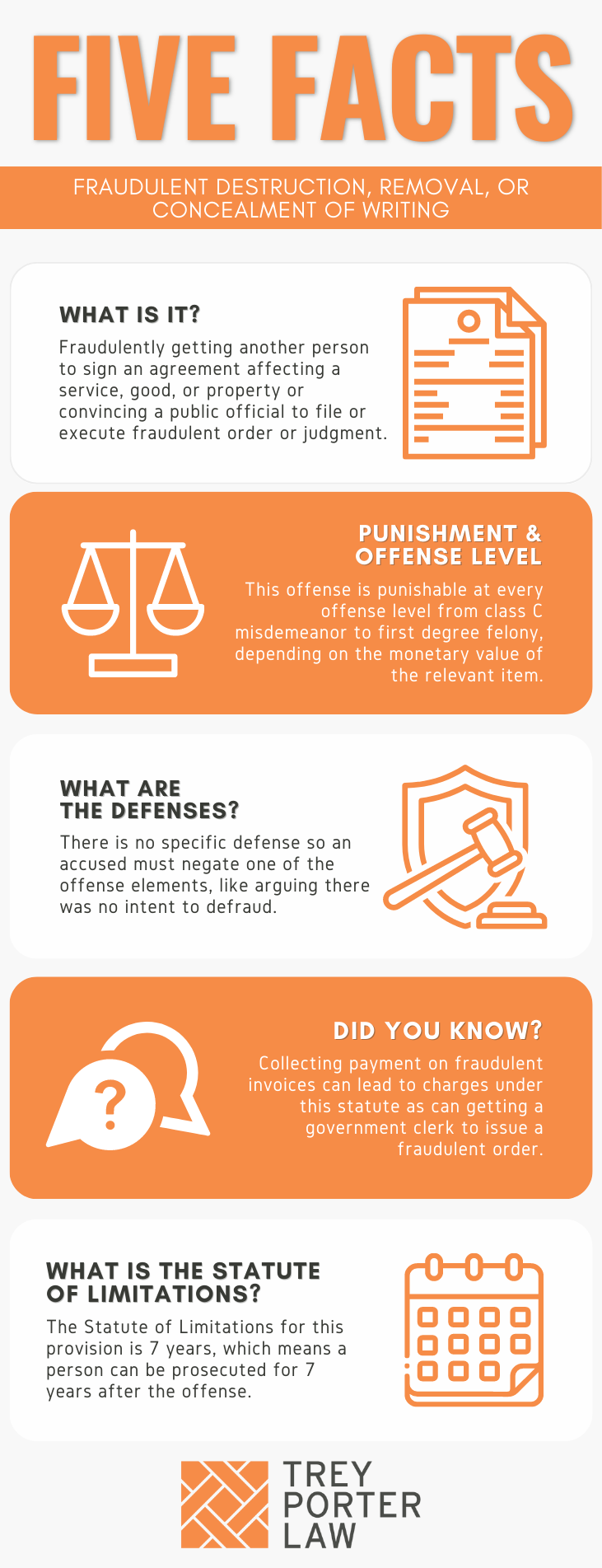WHAT IS FRAUDULENT DESTRUCTION, REMOVAL, OR CONCEALMENT OF WRITING IN TEXAS?
The Texas law against fraudulent destruction, removal, or concealment of a writing prohibits destroying, removing, concealing, altering, substituting, or otherwise impairing the legibility of a “writing,” other than a governmental record.

- What is a “writing”? Texas Penal Code Section 32.47 defines a “writing” to include: (1) printing or any other method of recording information; (2) money, coins, tokens, stamps, seals, credit cards, badges, trademarks; (3) symbols of value, right, privilege, or identification; and (4) universal product codes, labels, price tags, or markings on goods.
- What is an example of fraudulent destruction, removal, or concealment of a writing? An example of violating the Texas law against destroying, removing, or concealing a writing is switching or removing price tags.
WHAT IS THE FRAUDULENT DESTRUCTION, REMOVAL, OR CONCEALMENT OF WRITING LAW IN TEXAS?
Tex. Penal Code § 32.47. FRAUDULENT DESTRUCTION, REMOVAL, OR CONCEALMENT OF WRITING
(a) A person commits an offense if, with intent to defraud or harm another, he destroys, removes, conceals, alters, substitutes, or otherwise impairs the verity, legibility, or availability of a writing, other than a governmental record.
. . .
(c) Except as provided by Subsection (d), an offense under this section is a Class A misdemeanor, provided that:
(1) the writing is not attached to tangible property to indicate the price for the sale of that property; and
(2) the actor did not engage in the conduct described by Subsection (a) with respect to that writing for the purpose of obtaining the property for a lesser price indicated by a separate writing.
(d) An offense under this section is a state jail felony if the writing:
(1) is a will or codicil of another, whether or not the maker is alive or dead and whether or not it has been admitted to probate; or
(2) is a deed, mortgage, deed of trust, security instrument, security agreement, or other writing for which the law provides public recording or filing, whether or not the writing has been acknowledged.
(e) If at the time of the offense the writing was attached to tangible property to indicate the price for the sale of that property and the actor engaged in the conduct described by Subsection (a) with respect to that writing for the purpose of obtaining the property for a lesser price indicated by a separate writing, an offense under this section is:
(1) a Class C misdemeanor if the difference between the impaired writing and the lesser price indicated by the other writing is less than $100;
(2) a Class B misdemeanor if the difference between the impaired writing and the lesser price indicated by the other writing is $100 or more but less than $750;
(3) a Class A misdemeanor if the difference between the impaired writing and the lesser price indicated by the other writing is $750 or more but less than $2,500;
(4) a state jail felony if the difference between the impaired writing and the lesser price indicated by the other writing is $2,500 or more but less than $30,000;
(5) a felony of the third degree if the difference between the impaired writing and the lesser price indicated by the other writing is $30,000 or more but less than $150,000;
(6) a felony of the second degree if the difference between the impaired writing and the lesser price indicated by the other writing is $150,000 or more but less than $300,000; or
(7) a felony of the first degree if the difference between the impaired writing and the lesser price indicated by the other writing is $300,000 or more.
WHAT IS THE PENALTY CLASS FOR FRAUDULENT DESTRUCTION, REMOVAL, OR CONCEALMENT OF WRITING IN TEXAS?
The penalty classification for fraudulent destruction, removal, or concealment of a writing depends on the type of writing, or if committed by switching price tags, the difference between the real price of the property and the fraudulent replacement price.
- Class C misdemeanor, punishable by a maximum $500 fine, if:
- the difference between the impaired writing and the lesser price is less than $100;
- Class B misdemeanor, punishable by up to 180 days in county jail, if:
- the difference between the impaired writing and the lesser price is $100 or more but less than $750;
- Class A misdemeanor, punishable by up to one year in county jail, if:
- the difference between the impaired writing and the lesser price is $750 or more but less than $2,500; or
- the offense was committed in any manner other than switching price tags;
- State jail felony, punishable by 180 days to two years in a state jail facility, if:
- the writing was a will, codicil, deed, mortgage, deed of trust, security instrument, security agreement, or other writing for which the law provides public recording or filing; or
- the difference between the impaired writing and the lesser price is $2,500 or more but less than $30,000;
- Third degree felony, punishable by two to ten years in prison, if:
- the difference between the impaired writing and the lesser price is $30,000 or more but less than $150,000;
- Second degree felony, punishable by two to 20 years in prison, if:
- the difference between the impaired writing and the lesser price is $150,000 or more but less than $300,000;
- First degree felony, punishable by five to 99 years or life in prison, if:
- the difference between the impaired writing and the lesser price is $300,000 or more.
WHAT IS THE PUNISHMENT RANGE FOR FRAUDULENT DESTRUCTION, REMOVAL, OR CONCEALMENT OF WRITING IN TEXAS?
The punishment range for fraudulent destruction, removal, or concealment of a writing increases with the price difference if committed by switching price tags, or differs based on the character of the writing.
- First degree felony, if the price difference is $300,000 or more:
- five to 99 years or life in prison, maximum $10,000 fine;
- Second degree felony, if the price difference is $150,000 or more but less than $300,000:
- two to 20 years in prison, maximum $10,000 fine;
- Third degree felony, if the price difference is $30,000 or more but less than $150,000:
- two to ten years in prison, maximum $10,000 fine;
- State jail felony, if the writing is a will, codicil, mortgage, deed, or other publicly recorded and filed document, or if committed by switching price tags, the price difference is $2,500 or more but less than $30,000:
- 180 days to two years in a state jail facility, maximum $10,000;
- Class A misdemeanor, by default, or if committed by switching price tags, the price difference is $750 or more but less than $2,500:
- up to one year in jail, maximum $4,000 fine;
- Class B misdemeanor, if the price difference is $100 or more but less than $750:
- up to 180 days in jail, maximum $2,000 fine;
- Class C misdemeanor, if the price difference is less than $100:
- maximum $500 fine.
WHAT ARE THE PENALTIES FOR FRAUDULENT DESTRUCTION, REMOVAL, OR CONCEALMENT OF WRITING IN TEXAS?
A person charged with fraudulent destruction, removal, or concealment of a writing may be eligible for probation after a conviction, or deferred adjudication without a conviction. The length of community supervision depends on the offense category.
There is no community supervision required after a Class C misdemeanor conviction, but a person charged with a Class C misdemeanor fraud may be placed on deferred adjudication for up to 180 days.
The period of community supervision for Class A or Class B misdemeanors may not exceed two years. Pursuant to Texas Code of Criminal Procedure article 42A.302, a judge may order up to 30 days in jail as a condition of misdemeanor community supervision.
The period of community supervision for a state jail felony fraud is from two to five years, with the possibility of extending supervision for up to ten years.
For a third degree felony fraud charge, a person may be placed on deferred adjudication for up to ten years, or probation for a period between two and five years.
The period of community supervision for first degree felony and second degree felony fraud charges may not exceed ten years. Pursuant to Texas Code of Criminal Procedure article 42A.302, a judge may also order up to 180 days in jail as a condition of felony community supervision.
WHAT ARE THE DEFENSES TO FRAUDULENT DESTRUCTION, REMOVAL, OR CONCEALMENT OF WRITING IN TEXAS?
The statute does not authorize specific defenses to fraudulent destruction, removal, or concealment of a writing. A person accused thereof may attempt to negate at least one of the elements the State must prove at trial.
WHAT IS THE STATUTE OF LIMITATIONS FOR FRAUDULENT DESTRUCTION, REMOVAL, OR CONCEALMENT OF WRITING IN TEXAS?
The limitation period for fraudulent destruction, removal, or concealment of a writing classified as a misdemeanor is two years. If categorized as a felony, the limitation period is three years.
FRAUDULENT DESTRUCTION, REMOVAL, OR CONCEALMENT OF WRITING IN TEXAS
The Texas law against fraudulent destruction, removal, or concealment of a writing, which prohibits switching price tags and using false UPC labels, was enacted in 2001 in response to a proliferation of such offenses affecting retailers and other customers.
TEXAS FRAUDULENT DESTRUCTION, REMOVAL, OR CONCEALMENT OF WRITING COURT CASES
The case law regarding fraudulent destruction, removal, or concealment of a writing in Texas explains how appellate courts determine an accused’s intent to defraud.
- What is the intent to defraud or harm another? The Texas Penal Code does not define “defraud,” but appellate courts have observed the common thread running through the various schemes and plots in criminal fraud cases is that the defendant participated in some form of deceit or deception. Fraud involves trickery, deceit, intentional misrepresentation, concealment, or nondisclosure for the purpose of inducing another to part with some valuable thing belonging to him.In In re E.P., the juvenile defendant was adjudicated of fraudulently removing price tags after Walmart loss prevention saw her remove price tags and put the items in her pockets, intending to steal them. The appellate court affirmed the conviction, explaining the removal of price tags indicates an intent to defraud Walmart by stealing items without paying for them.












